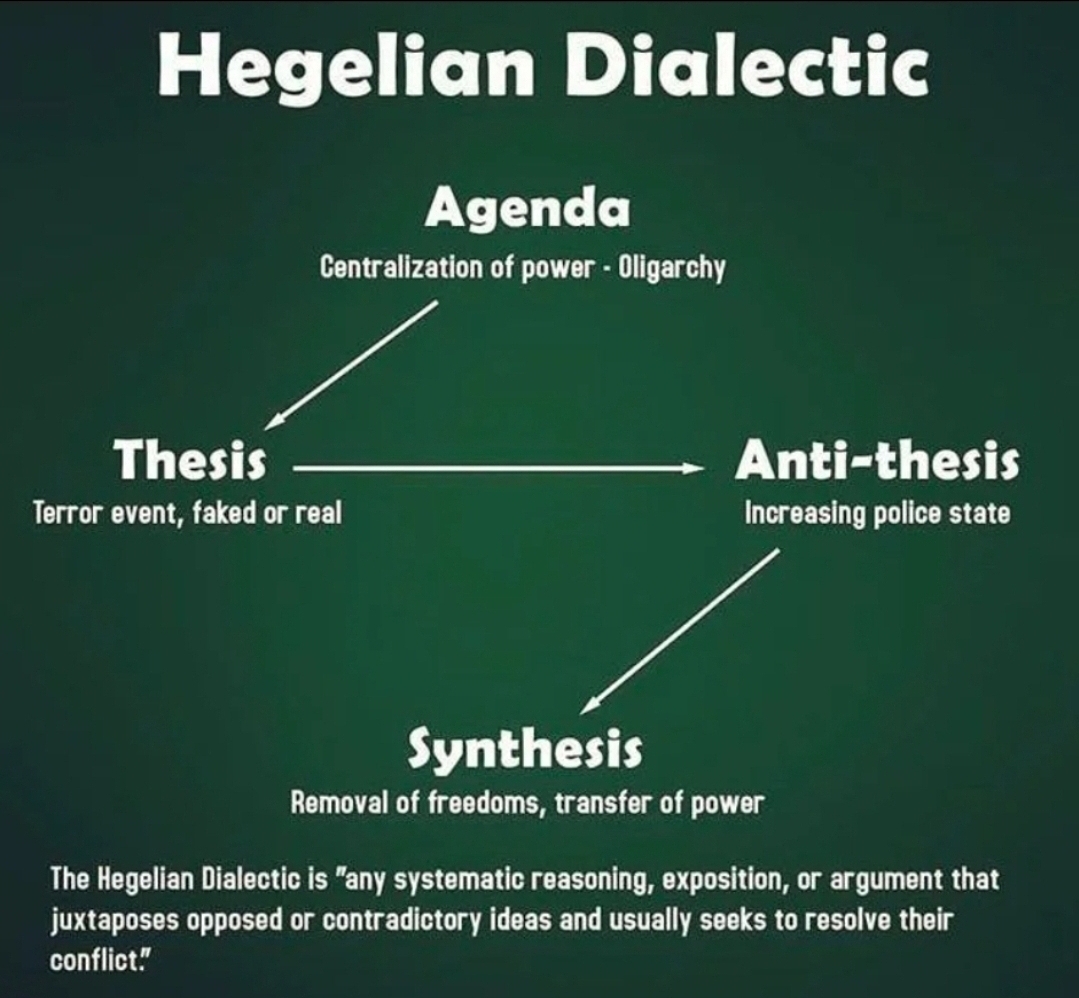The Hegelian Dialectic, derived from the philosophy of Georg Wilhelm Friedrich Hegel, is a method of reasoning and argument that involves the interaction of opposing forces to arrive at a new synthesis. While Hegel’s original use of the dialectic was philosophical, focusing on the evolution of ideas, the concept has been co-opted as a tool by those seeking to manipulate and control societies, particularly by tyrants or those in power.
Understanding the Hegelian Dialectic:
- Thesis, Antithesis, Synthesis:
- Thesis: Represents an existing idea, condition, or status quo.
- Antithesis: Represents the opposition or reaction to the thesis, often a conflicting idea or force.
- Synthesis: The resolution or merging of the thesis and antithesis, resulting in a new situation or condition that incorporates elements of both.

In a societal context, this process can be used to create change or steer public opinion by controlling the thesis and antithesis to produce a desired synthesis.
How Tyrants Use the Hegelian Dialectic as a Tool:
- Manufacturing Crises (Thesis):
- Creating a Problem: A tyrant might intentionally create or amplify a problem, crisis, or conflict within society. This could be anything from economic instability to social unrest, terrorism, or a public health crisis.
- Framing the Issue: The problem is framed in such a way that it demands immediate attention and action, often leading the public to feel a sense of urgency or fear. In essence, they control the narrative.
- Manipulating the Opposition (Antithesis):
- Encouraging or Controlling the Reaction: In response to the manufactured crisis, a reaction is either organically provoked or artificially steered by the tyrant. This reaction might include public outrage, protests, or calls for change.
- Polarization: The tyrant may deliberately exacerbate divisions in society, creating a strong opposition that seems to challenge the original thesis but is still within the parameters that the tyrant controls or anticipates.
- Imposing the Desired Solution (Synthesis):
- Offering a Pre-Determined Solution: Once the public is sufficiently divided and the crisis has reached a peak, the tyrant offers a solution that appears to resolve the conflict. This solution often involves an increase in government control, loss of individual freedoms, or other measures that would have been unacceptable under normal circumstances.
- Gaining Public Support: The public, desperate for stability and resolution, may accept or even welcome the proposed solution, not realizing it was the intended outcome all along.
Examples of Hegelian Dialectic in Practice:
- Expansion of Government Powers: After a significant terrorist attack or national crisis, governments may introduce new security measures (thesis). Public fear and the desire for safety create a reaction (antithesis). The resulting synthesis is the acceptance of increased surveillance and restrictions on personal freedoms, which might not have been possible without the initial crisis.
- Economic Manipulation: A government might intentionally allow an economic downturn (thesis), leading to widespread unemployment and social unrest (antithesis). The synthesis could be the implementation of strict economic controls or social programs that increase the government’s influence over the economy, effectively consolidating power.
The Hegelian Dialectic can be a powerful tool for tyrants, enabling them to manipulate societal change and control public opinion.
By manufacturing crises and steering the resulting opposition, they can guide society toward a pre-determined outcome that serves their interests (Tyrants Weapons: Overton Window), often at the expense of individual freedoms and democratic republic values. Understanding this process helps recognize when such manipulative tactics are employed, empowering citizens to resist authoritarian control and maintain their autonomy.







One Response
https://www.bitchute.com/video/ApD5TIQsvnst the other 3 links are below the video on that page Cult of the Medics series